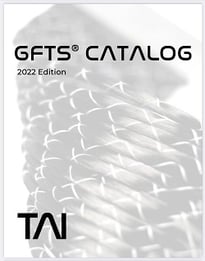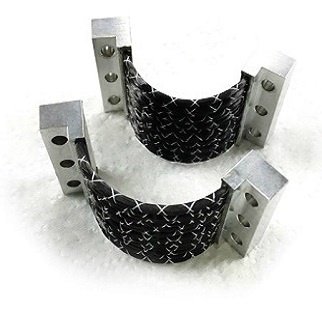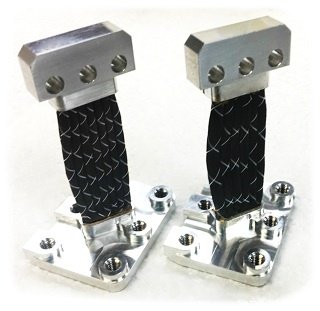GRAPHITE FIBER THERMAL STRAPS (GFTS®)
THE WORLD'S MOST WIDELY-USED GRAPHITE THERMAL LINK
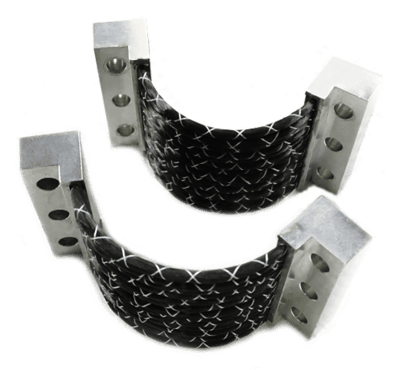 TAI provides the world's only Graphite Fiber Thermal Links/Straps (GFTS®), and the only carbon-based strap standard product lines. GFTS® assemblies are the space industry's standard for lightweight, high conductance, flexible straps, and TAI alone has the graphite thermal link spaceflight heritage required by NASA, JAXA, and ESA. GFTS® assemblies are used to cool a wide range of products from star trackers, to cryocoolers, optical systems, radiators, electronics boxes and other electrical components on a large number of space flight missions (including the ORION and CST-100 commercial crew vehicles, as well as EnMAP, GRACE-FO, Solar Orbiter, IXPE, and more), and have extensive spaceflight history; setting them apart from all other carbon straps.
TAI provides the world's only Graphite Fiber Thermal Links/Straps (GFTS®), and the only carbon-based strap standard product lines. GFTS® assemblies are the space industry's standard for lightweight, high conductance, flexible straps, and TAI alone has the graphite thermal link spaceflight heritage required by NASA, JAXA, and ESA. GFTS® assemblies are used to cool a wide range of products from star trackers, to cryocoolers, optical systems, radiators, electronics boxes and other electrical components on a large number of space flight missions (including the ORION and CST-100 commercial crew vehicles, as well as EnMAP, GRACE-FO, Solar Orbiter, IXPE, and more), and have extensive spaceflight history; setting them apart from all other carbon straps.
GFTS® products differ from Graphene Foil and Pyrolytic Graphite Sheet (PGS) Links (offered by TAI and others) because they offer:
-
Vibration damping due to our unique bundling of the fiber ropes (or "tows").
-
Flexibility on all 3 axes (without an S-shaped installation configuration).
-
Durability - they are far more robust than carbon film/sheet/foil configurations.
-
Lower Prices - GFTS® assemblies have lower labor and material costs than PGF or Graphene-based products, and similarly-priced or cheaper than competing metallic foil straps.
- Extensive Space Flight Heritage & Qualification - GFTS® are NASA TRL 9, and hundreds of assemblies have flown on numerous NASA, ESA, JAXA, and US DoD missions.
TAI manufactures hundreds of GFTS® Prototype, Proto-Flight (PF), and Flight Model (FM) units each year, and is currently filling 3rd and 4th round follow-on orders of FM straps for spaceflight programs like NASA's ORION Multi-Purpose Crew Vehicle.
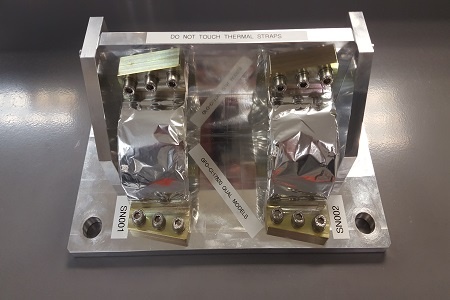
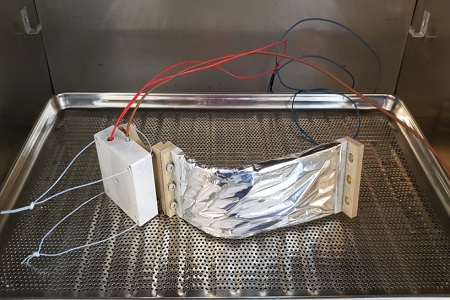

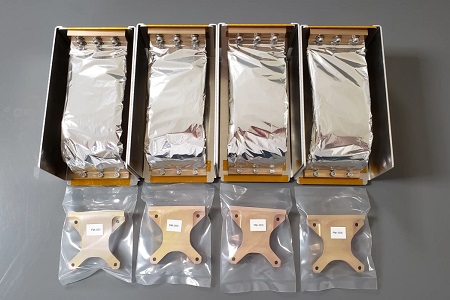

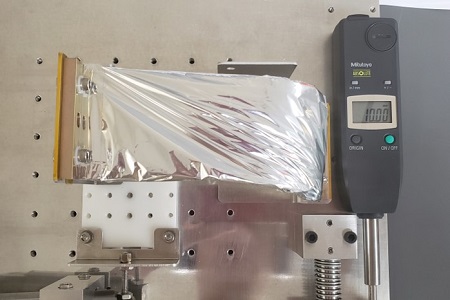


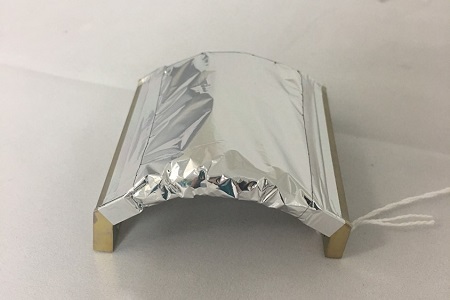
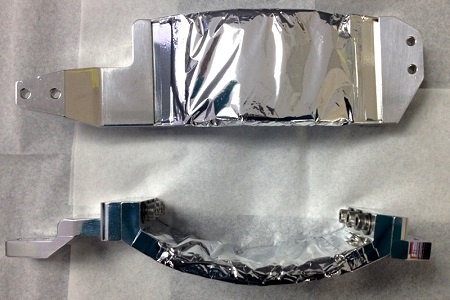
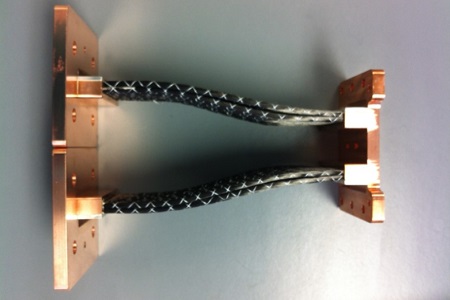
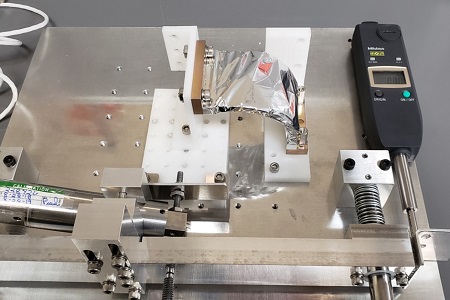
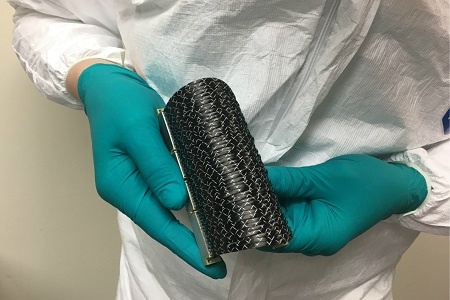

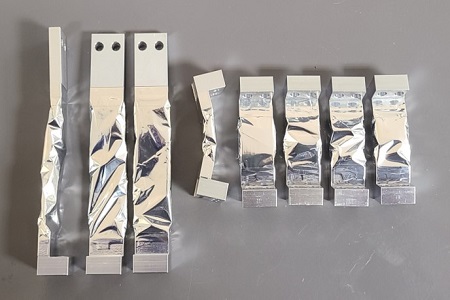
Visit our Previous GFTS® Designs & Space Flight Models Gallery
CUSTOM AND STANDARD MODELS
With the introduction of our standard series straps, customers can now choose from 6 standard models (with two different end fitting options), without the additional expense of NRE and Design Fees associated with previous GFTS® prototype programs. As a result, customers—even those with budget-restricted ground based and airborne applications—can now afford a space-qualified, flexible graphite strap product.
All standard and custom GFTS assemblies are made using low/zero outgassing, well under NASA's published limits for spaceflight hardware. Each graphite thermal strap comes with optional aluminized mylar encapsulation sleeves, and chromated end fittings.
To request a copy of the 2020 GFTS® Catalog, click here now.
ORDERING YOUR GFTS®
If you have already selected your standard GFTS® model(s) from the catalog, please download and complete our Questionnaire and Ordering form, and submit the questionnaire to our Director of Business Development at tlink@techapps.com, to receive your quote.
|
STANDARD GFTS®
|
CUSTOM GFTS®
|
WHY USE A GRAPHITE FIBER THERMAL STRAP?
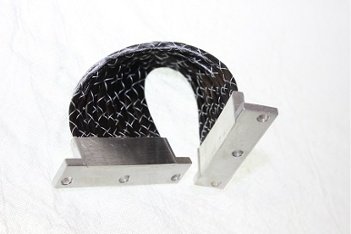
-
Unrivaled Vibration Damping- GFTS® products offer superior vibration damping/isolation to metallic straps, and while our PGF links offer vibration isolation due to their low material stiffness, they do not offer vibration damping, like a GFTS® solution. GFTS® assemblies can also be integrated with shock and vibration mitigation systems, and other damping and isolator systems, to provide thermally conductive lightweight vibration isolation.
-
Durability - unlike Pyrolytic Graphite and Graphene sheets/films/foils, GraFlex™ fiber bundles (and woven sheets), are not as easily damaged by routine handling or installation, repeated flexing, or lateral deflection when installed in straight, C, and J-shaped configurations (see heritage data at the bottom of this page).
-
Lateral Deflection / Flexibility - while Pyrolytic Graphite and Graphene sheets/foils are more flexible on the compression and vertical axes, lateral deflection will destroy these strap types (unless they are designed into longer, and less efficient C/U and S-shapes). If your program requires lateral deflection of greater than 2.54mm (without sufficient envelope to accommodate an S-shape or 180 degree arc), a graphite fiber thermal strap is the only carbon-based strap solution available.
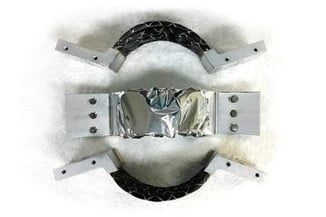
-
Price - TAI's GraFlex™ rope is a small fraction of the cost of PGF and Graphene foil, and less assembly time is required per unit. As a result, GFTS® unit and program costs are similar to those of stacked metallic foil straps and slightly cheaper than any PGSF or Graphene-based thermal strap.
-
Improved Flexibility over Metallic Foil Straps - stacked metallic foil configurations often lack flexibility on all axes. Because of this, they need to be assembled and installed in much longer, larger (and heavier), "S" and "U-shaped" configurations, to give them (limited) flexibility on the compression and lateral axes (often negating the benefits of an AlTS™ to begin with). GFTS® products—while not as flexible as a copper cabled configuration—offer flexibility on all axes.
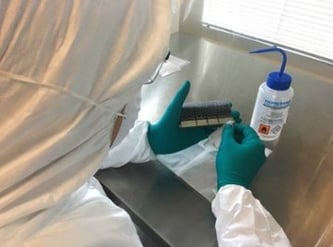
-
High Thermal Conductivity to Low Mass Ratio - on a thermal conductivity/mass basis, GraFlex™ is 12x more efficient than copper (at 300K), and the average GFTS® strap weighs just 1/5 - 1/10 the mass of an equivalent-sized metallic strap (most custom and standard straps weigh only 10 - 30g).
-
High Conductance to Low Interface Area Ratio - end fittings/terminal blocks are not integral to thermal performance. As a result, they can be made much smaller than the large fittings/footprints required by metallic straps.
-
Spaceflight Heritage - GFTS® have extensive spaceflight heritage, and qualified by NASA, JAXA, DLR, Lockheed Martin, Honeywell, the DoD, and over a dozen other aerospace organizations and companies (some which cannot be named due to NDA's and cybersecurity policies), and are used in numerous missions & programs from the CST-100 Starliner, to ORION, ASTRO-H, SORA, and many more.
Pictured (Top Right): Custom GFTS® with GraFlex I Bundles. (Middle): Custom, First Generation GFTS® with GraFlex II Bundles, Extended Foot Plates. (Bottom): Technician cleaning ORION GFTS® Assembly.
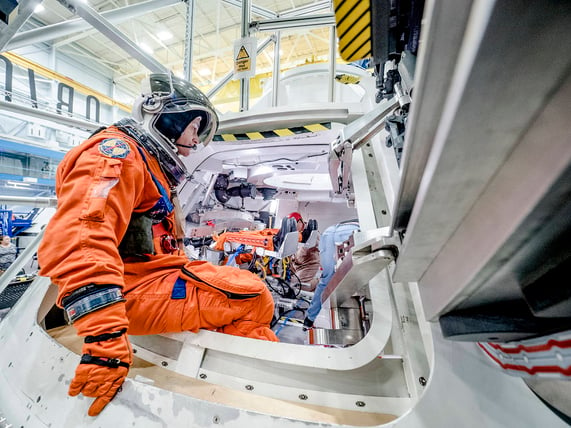
Though graphite thermal straps / "thermal shunts" / "thermal cables" have been studied since the late 1960's, TAI alone, perfected and fabricates the only graphite fiber thermal strap products. We began research on, and built our first GFTS® in 1996, and were later awarded USAF SBIR Ph I and follow-on Ph II programs (in 1996 & 1997), to further develop GFTS® and thermally-conductive vibration isolation technology for cryocoolers.
TAI's GFTS® assemblies not only have spaceflight heritage; they have been subjected to--and successfully passed--some of industry's most grueling qualification/test requirements ever applied to thermal strap products, in Boeing's CST-100 Starliner, and JAXA's ASTRO-H programs (see our spaceflight qualification data table at the bottom of the page).GFTS® assemblies are now used in both space and ground-based applications, in applications including: antennas, electronics boxes, battery pack cooling, radiators, cryocoolers, optical systems, SWIR & VNIR cameras, star trackers, cryogenic refrigerator compressors, communication & radar power electronic systems, and electromechanical systems.
GFTS® SPACE FLIGHT HERITAGE
The list below details just a handful of the programs and that have launched with our straps, or are set to launch in the near future:
-
NASA's ORION Spacecraft - December 2015. TAI designed and assembled dozens of GFTS® assemblies (for NASA and multiple aerospace organizations), for the Data Acquisition Systems and Phased Antenna Arrays on the Orion Multi-Purpose Crew Vehicle. TAI is still filling follow-on FM orders for ORION at present.
-
JAXA's ASTRO-H (Hitomi) - February 2016. TAI designed and assembled dozens of GFTS® assemblies for JAXA, for PC-B Compressors, and cryocoolers on ASTRO-H.
-
NASA JPL's GRACE-FO - May 22 2018. TAI designed assembled prototype and FM GFTS® and CuTS® assemblies for Airbus and NASA JPL.
-
USAF's GPS III - December 23, 2018. TAI designed and assembled numerous prototype and FM GFTS® assemblies for Honeywell and other prime contractors on the program.
-
Numerous Department of Defense Satellite Programs (Program Names Withheld) - 2016 - 2019, and others set for launch in 2018 - 2020. TAI is currently filling follow-on FM orders for multiple programs.
-
ESA & NASA's Spectral Imaging of the Coronal Environment (SPICE) instrument (on Solar Orbiter) - February 2020. TAI designed and assembled multiple straps to cool chips and other components.
-
Boeing's CST-100 Commercial Crew Vehicle - August 2019. TAI designed and assembled over 100 prototype and FM GFTS® assemblies for the crew module battery system.
-
DLR's EnMAP - April 2022. TAI designed and assembled prototype and FM GFTS® assemblies for the SWIR detectors.
-
GEMS UV-VIS Spectrometer (GEO-KOMPSAT-2B Satellite) - February 2020. TAI designed and assembled proto-flight GFTS® assembly to provide mechanical decoupling with heat pipe.
-
NASA’s IXPE Mission – April 2021. TAI provided several prototype and spaceflight model GFTS / TEC Hybrid Thermal Straps to INFN and NASA.
- TNO & Hyperion's CubeCat Instrument - April 2023. TAI provided multiple straps to cool the CoolCat laser communication instrument to be used on commercial CubeSats across the globe.
- ESA's Comet Interceptor's spacecraft - Launches 2029. TAI provided multiple straps to cool the CoCa instrument on the main satellite A.
-
TAI has also provided prototype and FM GFTS® assemblies for several other customers including: OHB, Thales Alenia, Selex, CSA-Moog, Toshiba, NRL, L-3 and others
Pictured (Top Left): ORION spacecraft (photo credit: NASA).
WHAT MATERIALS ARE USED?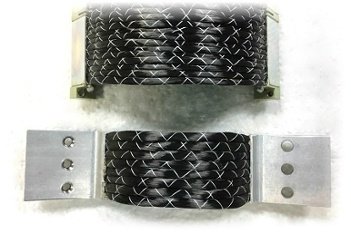
TAI manufactures our GFTS® product using our GraFlex bundles (GraFlex I and II), and our new GraFlex III Woven Graphite Fiber Sheet (made from graphite fiber with thermal conductivity of 800 - 1,000 W/m-K). Each GraFlex bundle consists of thousands of individual carbon fibers wrapped with a special polyester cord for support. These graphite fibers have 2.75 times the thermal conductivity of copper at room temperature and one-quarter of the density. Therefore, on a thermal conductivity/mass basis, they are twelve times more weight-efficient than copper, and over six times more weight-efficient than aluminum.
Our proprietary GFTS® fabrication process realizes up to 95% of the material thermal conductivity while providing a metal interface configuration for bolting the strap between the heat source and sink. The graph below shows the temperature-dependent thermal conductivity of the graphite fiber in comparison with other typical thermal strap materials. End fittings are made using a variety of materials (though aluminum is the most common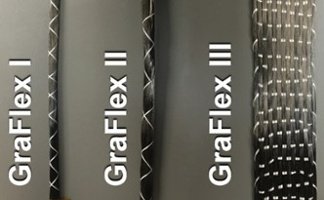 choice for most applications). All GFTS® assemblies are made using only NASA-approved, extremely-low outgassing materials, making them ideal for contamination sensitive applications.
choice for most applications). All GFTS® assemblies are made using only NASA-approved, extremely-low outgassing materials, making them ideal for contamination sensitive applications.
Pictured (Top): Custom GFTS® with GraFlex I Above Custom GFTS® with GraFlex II. (Bottom): GraFlex I, GraFlex II (twice the number of fibers as GraFlex I), and GraFlex III woven fiber sheet.
STRAP MATERIAL THERMAL CONDUCTIVITY
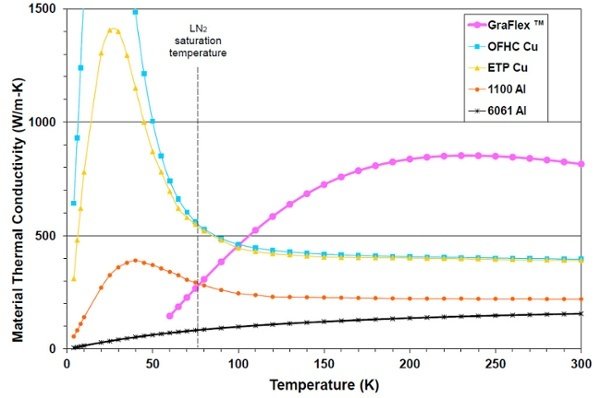
GFTS® SPACE QUALIFICATION DATA
GFTS® assemblies have undergone extensive testing and qualification under severe environmental and launch conditions. If your program requires stiffness, shock, vibration, or other types of qualification testing, our team is happy to work with you to develop your SOW and spec accordingly. In the table below, you can find examples of some of the testing extremes which our straps have undergone in previous space flight programs.
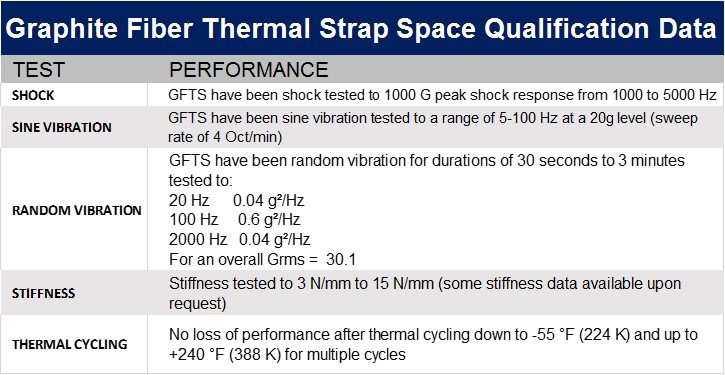
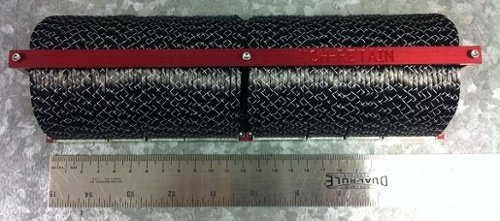
Pictured: GFTS® FM Assemblies in Handling Fixture - NASA ORION Spacecraft (FM Hardware Designed & Fabricated April 2016).
GFTS® FLEXIBILITY DEMONSTRATIONS
Flexibility and stiffness have long been a concern in thermal straps used in satellites and other aerospace applications. To see videos of our GFTS flexibility demonstrations, click here now.

